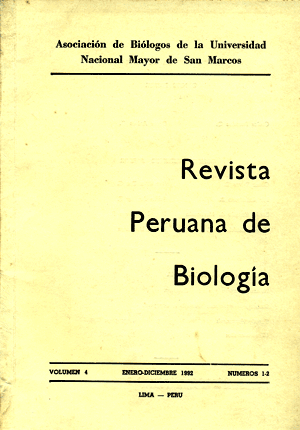Mycoplasma detection in a mouse cell line and possible contamination source
DOI:
https://doi.org/10.15381/rpb.v4i1-2.8335Keywords:
mycoplasmaAbstract
The detection of contaminating mycoplasma in a NS-1 myeloma celI line was studied comparing three methods The probable source of mycoplasma contamination were some batches of commercial sera Fetal Bovine Sera (FBS) mouse myeloma NS-1 cells and Vero celIs (African green monkey) were cultured on PPLO medium. The other methods involved the use of an indicator cell culture system (Vero cells) and the DNA-fluorochrome staining technique. The bacteriological procedure for the isolation of mycoplasma was successful with NS-l and Vero celIs, but not with FBS. However, mycoplasma colonies with typical "fried egg" appearance were only observed with Vero celIs. Moreover, the number of colonies isolated could be appreciated only after 18 days of growth. Vero tested, showed cytopathic effect (CPE). Initial1y, dark grasules appeared in the cytoplasm of the cells. At the 5th or 7th day, cell membranes showed small linger-like projections and vacuolization. By the 3rd or 4th week, the CPE was more pronounced. Monolayers of Vero cells were a1so grown on coverslips for 2 to 5 days and were stained with Hoechts DNA: fluorescent stain. The cells show discrete zones of fluorescence in the cytoplasm and nuclei. The: fluorescent spots were time-dependent Hoechst technique appears to be the method 01 choice, since it is more efficient, less time consuming and simpler.Downloads
Downloads
Published
Issue
Section
License
Copyright (c) 1992 Willian Cornejo M., Libertad Alzamora G.

This work is licensed under a Creative Commons Attribution-NonCommercial-ShareAlike 4.0 International License.
AUTHORS RETAIN THEIR RIGHTS:
a. Authors retain their trade mark rights and patent, and also on any process or procedure described in the article.
b. Authors retain their right to share, copy, distribute, perform and publicly communicate their article (eg, to place their article in an institutional repository or publish it in a book), with an acknowledgment of its initial publication in the Revista Peruana de Biologia.
c. Authors retain theirs right to make a subsequent publication of their work, to use the article or any part thereof (eg a compilation of his papers, lecture notes, thesis, or a book), always indicating its initial publication in the Revista Peruana de Biologia (the originator of the work, journal, volume, number and date).






